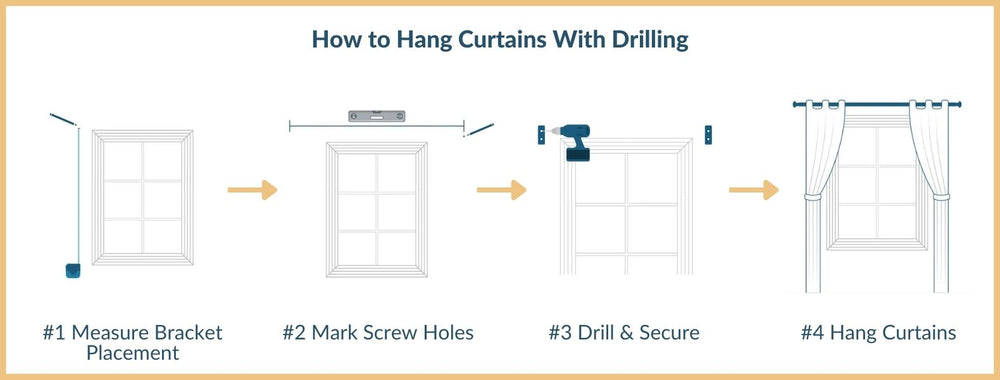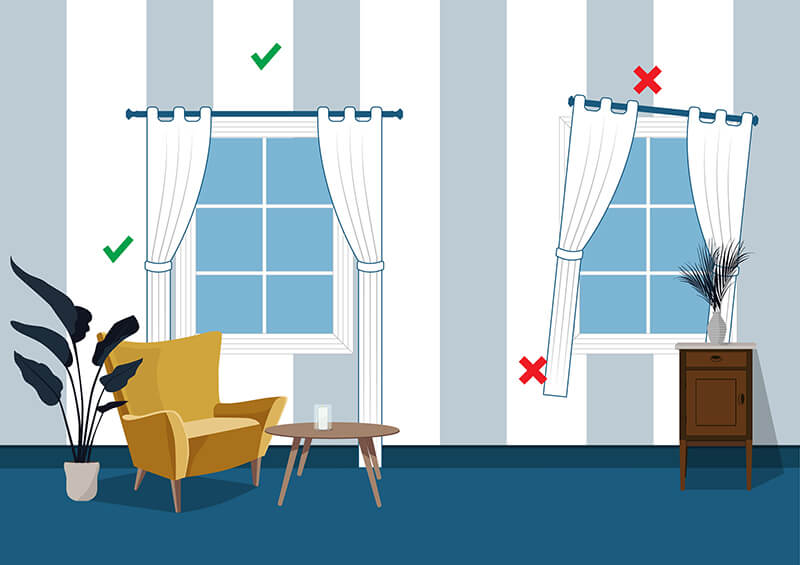How to Hang Curtains With & Without Drilling

Curtains are a critical interior design element and popular home improvement project. They’re stylish, practical and provide privacy and comfort. But the reality of hanging curtains isn't so glamorous.
There’s a lot to consider when selecting and hanging window treatments, not to mention the slew of tools required to bring your vision to life.
In this easy read, we’ll show you how to hang curtains step by step, with and without drilling. Knowing how to measure for curtains is the first step for either method.
Measure for Curtains in 5 Steps
Deciding on your curtain length and width will determine where you’ll hang them. Making mistakes here is how many people end up with curtains that are too long, too short, too wide or too narrow.
There are four steps to take when measuring for curtains.

1. How Long Should Your Curtains Be?
First, determine what style you’re going for. This decision is crucial for measuring correctly.
- Float: Curtains “float” less than one inch above the floor
- Kiss: Curtains barely touch the floor
- Puddle: Curtains are slightly longer, flaring out in a “puddle” on the floor
Measure the height from the floor to the top of the window frame (or the spot where your curtain rod will begin) to determine how long your curtains need to be. Remember to add a few inches if you want your curtains to puddle.
Standard curtain lengths are 63, 84, 96, 108 and 120 inches long.
Pro tip: Don’t forget to measure not only the length of your curtains but also the curtain rods and length of your curtain rings.
2. How High Should You Hang Your Curtains?
Curtain height is a matter of preference, ranging from the top of the window to four to six inches above it. If your windows have casings or trim, it’ll be far easier for you to install your curtain hardware without drilling.
3. Measure Your Window Depth
If you have a window frame, you’ll need to determine what size curtain rod brackets you need.
Curtain rod brackets are holders that support a curtain rod. You can install curtain rod brackets on a wall, a window frame or the ceiling.
Your brackets should extend past the depth of your window molding. If they're too shallow, your curtains won't hang correctly.
Your curtain type can also affect how deep your brackets should be. Rod pocket curtains need far less hanging space than grommet curtains, for instance.
4. How Wide Should Your Curtains Be?
Measure the width of your windows. Curtains should extend three to six inches beyond the side of your window on both sides for adequate coverage.
To ensure your curtains look full, even when closed, round up at least two times the width of the window to determine how many panels you need. You can round down if you’re not planning on closing your curtains or have pleated panels.
Depending on the size of your window, you may need to buy multiple curtain panels, an extra long curtain rod and center support brackets.
For more measuring tips, check out How to Measure for Curtains the Right Way.
5. Choose a Curtain Rod Bracket Type
Popular curtain rod styles include standard adjustable rods, double rods (which help you layer curtains), tension rods and wraparound rods. The curtain rod style you choose will dictate the type of curtain rod bracket you’ll need.
In addition, the diameter of your curtain rods will determine the size of the curtain rod brackets you’ll need. Brackets are available in two standard widths that “cradle” your curtain rod and hold it in place: 5/8-inch and 1-inch.
Once you determine the correct curtain size and preferred curtain rod type, you can move on to installing curtain rod brackets via your chosen installation method: With or without drilling.
How to Hang Curtains: Drilling Method
Here’s how to hang curtains with drilling.

Get the Right Tools
To hang curtains the “traditional” way, you’ll need to have the right materials and tools on hand:
- Screws
- Tape measure
- Level
- Stud finder
- Screwdriver or drill
- Pencil and paper
Measure for Bracket Placement
With your curtain style in mind, measure the height where you want your curtain panels to hang.
Mark Screw Hole Placement
Use a pencil and tape measure to mark curtain bracket placements on the wall. Use a level to line up the pencil markings so the curtain rod will hang evenly.
Starting with the right side, place the bracket over the center of the mark. Use a level and pencil to mark the holes where the screws will go.
Drill and Secure the Bracket
Use a stud finder to locate studs in the wall. If there are studs where you’re hanging curtains, you’ll just need screws. If there isn’t a stud, use a screw and anchor.
Pre-drill pilot holes for the screws with a 1/8" bit. Insert the screws into the holes, leaving 1/4" of the screw sticking out. Slide the bracket onto the screws and tighten the screws to secure the bracket to the frame.
Level and Secure the Other Bracket
Place the curtain rod into the right bracket. Use a level to determine the placement of the left bracket. Repeat steps 2-3 to secure the bracket to the frame.
Hang Your Curtains
To hang your curtains correctly, slide the rod through the pocket, loops or tabs at the top of your curtains. Then, gently place the rod into the brackets.
How to Hang Curtain Rods Without Drilling
Any homeowner or property manager knows that hanging curtains is a major headache. If you've ever tried hanging curtains the traditional way, you're probably familiar with these issues:
-
Time-Consuming
Hanging curtains can easily turn into an all-day ordeal that involves multiple people.
-
Frustrating
Hanging and re-hanging unstable or crooked curtains is downright stressful.
-
Expensive
To hang curtains on every window in your home, you need excess tools and screws. These expenses add up fast.
-
Causes Wall Damage
Wall damage is costly to fix and sucks money out of the security deposit as a renter.
Thankfully, a solution for hanging curtains without drilling is within reach. Install Kwik-Hang curtain rod brackets in three easy steps:

Kwik-Hang's revolutionary, no-drill curtain rod brackets let you hang curtains in seconds. They are safe, durable and sturdy and can accommodate windows of any size and design. And with multiple color options, you'll have no trouble finding the right Kwik-Hang brackets to complement your windows and decorating style.
Pro Tips for Hanging Curtains: Do’s and Don’ts
Keep these tips in mind when you’re hanging curtains.


DO use enough fabric. You want your curtains to feel full. If you plan to close your curtains from time to time, they should be 2-2.5 times the width of the window.

DO measure carefully. Crooked curtains are an eyesore. They're not only a pain to rehang, it causes unnecessary damage and holes in your walls. Triple-check your measurements before hanging your curtains.

DON'T make your curtains too short.
The fabric should sweep the floor or puddle slightly. A few inches of puddling looks nice if you want a romantic look. But if you don't want them to drag or get dirty, stop the fabric just under an inch from the floor.

DON'T choose a curtain rod that is too narrow.
Select a curtain rod that is 8-12 inches wider than your window to ensure your curtains always cover the sides of the window.
How to Hang Curtains in Specific Situations
If you want to take your curtain-hanging game to the next level, try these new looks and techniques for hanging curtains in different situations.
Hang Curtains in Seconds With Kwik-Hang
Hanging curtains shouldn’t have to be a strenuous, stressful household chore.
Say goodbye to crooked curtains and wall damage for good, and make the right choice with Kwik-Hang’s no-drill curtain hardware and curtain rods.
Just align the brackets to your window trim, tap them in with a hammer or mallet and successfully hang your curtains or drapes in seconds!
No screws. No drills. No holes or damage. Zero stress.


